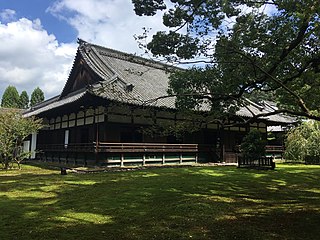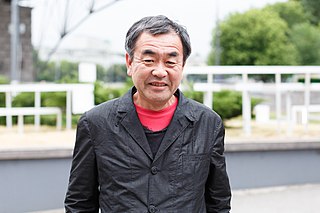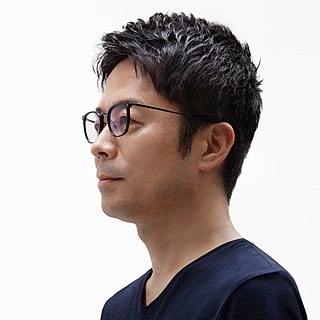
Chashitsu in Japanese tradition is an architectural space designed to be used for tea ceremony (chanoyu) gatherings.

Nijō Castle is a flatland castle in Kyoto, Japan. The castle consists of two concentric rings (Kuruwa) of fortifications, the Ninomaru Palace, the ruins of the Honmaru Palace, various support buildings and several gardens. The surface area of the castle is 275,000 square metres, of which 8,000 square metres (86,000 sq ft) is occupied by buildings.

Japanese gardens are traditional gardens whose designs are accompanied by Japanese aesthetics and philosophical ideas, avoid artificial ornamentation, and highlight the natural landscape. Plants and worn, aged materials are generally used by Japanese garden designers to suggest a natural landscape, and to express the fragility of existence as well as time's unstoppable advance. Ancient Japanese art inspired past garden designers. Water is an important feature of many gardens, as are rocks and often gravel. Despite there being many attractive Japanese flowering plants, herbaceous flowers generally play much less of a role in Japanese gardens than in the West, though seasonally flowering shrubs and trees are important, all the more dramatic because of the contrast with the usual predominant green. Evergreen plants are "the bones of the garden" in Japan. Though a natural-seeming appearance is the aim, Japanese gardeners often shape their plants, including trees, with great rigour.

Shūsaku Arakawa was a Japanese conceptual artist and architect. He had a personal and artistic partnership with the writer and artist Madeline Gins that spanned more than four decades in which they collaborated on a diverse range of visual mediums, including: painting & printmaking, experimental filmmaking, performance art, and architectural & landscape design.

Shōren-in (青蓮院) is a Buddhist temple in Kyoto, Japan.

Nishi Hongan-ji (西本願寺) is a Jōdo Shinshū Buddhist temple in the Shimogyō ward of Kyoto, Japan. It serves as the head temple of the sub-sect Honganji-ha.

Kengo Kuma is a Japanese architect and emeritus professor in the Department of Architecture at the University of Tokyo. Frequently compared to contemporaries Shigeru Ban and Kazuyo Sejima, Kuma is also noted for his prolific writings. He is the designer of the Japan National Stadium in Tokyo, which was built for the 2020 Summer Olympics. He is married to architect Satoko Shinohara, and they have one son, Taichi, also an architect. He is an advisor for Kitakyushu-city in Japan.

In Japan, an ochaya is an establishment where patrons are entertained by geisha. A now-archaic term that arose in the Edo period, ochaya in the modern day refers exclusively to the establishments within Kyoto in which geisha work and entertain their clients, though the term is sometimes used to describe all establishments used by geisha to entertain guests, irrespective of location.

SANAA is an architectural firm based in Tokyo, Japan. It was founded in 1995 by architects Kazuyo Sejima (1956–) and Ryue Nishizawa (1966–), who were awarded the Pritzker Prize in 2010. Notable works include the Toledo Museum of Art's Glass Pavilion in Toledo, Ohio; the New Museum of Contemporary Art in New York; the Rolex Learning Center at the EPFL in Lausanne; the Serpentine Pavilion in London; the Christian Dior Building in Omotesandō, Tokyo; the 21st Century Museum of Contemporary Art in Kanazawa; the Louvre-Lens Museum in France; and the Bocconi New Campus in Milan.

Tai-an (待庵) is a Momoyama period chashitsu located at Myōki-an temple in Yamazaki, Kyoto.

Sukiya-zukuri (数寄屋造り) is one type of Japanese residential architectural style. Suki means refined, well cultivated taste and delight in elegant pursuits, and refers to enjoyment of the exquisitely performed tea ceremony.

Tokujin Yoshioka is a Japanese designer and artist active in the fields of design, architecture and contemporary art. Some of his works are part of permanent collections in the Museum of Modern Art (MoMA), the Centre Pompidou in Paris, and the Victoria and Albert Museum in London. In 2007, he was named by Newsweek one of the 100 most respected Japanese in the world.
Tokyo Design Week (TDW), formally known as Tokyo Designers Week, was an annual design event that occurred from 2005–2016, at Meiji Jingu Gaien in central Tokyo, Japan. The event featured product design, interior design and had expanded to include art and graphic design as well as short films. Since 2005, Tokyo Design Week had been held at Meiji Jingu Gaien, near Gaienmae Station on the Tokyo Metro Ginza Line.

Karen LaMonte is an American artist known for her life-size sculptures in ceramic, bronze, marble, and cast glass.

Oksana Mas is a Ukrainian contemporary artist and the organizer of "ArtTogether", a global interactive art project aimed at visualizing the new cultural code of the modern generation and uniting people at a time of political and social turmoil.

The Japanese pavilion houses Japan's national representation during the Venice Biennale arts festivals.
Angelica Mesiti is an Australian multi-disciplinary artist of Italian descent, best known for her combination of performance with video, sound and spatial installation that result in highly contemplative spaces. Her work is situated at the interstice of diasporic cultures, gestural communication and sensory togetherness.
Narine Arakelian is an Armenian interdisciplinary feminist artist; she works with Performance art, Installation art, Painting, Sculpture, Video art and Environmental art combining Fine Arts and Digital Technologies by using the custom designed Artificial Intelligence (A.I.). The artist creates artworks based on social, cultural and political issues focusing predominantly on social justice and gender identity.



![Glass Tea House - KOU-AN, 2015 - 2017, Tendai Sect Shoren-in [garasunoCha Shi - Guang An ] /Jing Du Jiang Jun Zhong Qing Long Dian /20112015.jpg](http://upload.wikimedia.org/wikipedia/commons/thumb/8/83/%E3%80%8C%E3%82%AC%E3%83%A9%E3%82%B9%E3%81%AE%E8%8C%B6%E5%AE%A4_-_%E5%85%89%E5%BA%B5%E3%80%8D%EF%BC%8F%E4%BA%AC%E9%83%BD%E5%B0%86%E8%BB%8D%E5%A1%9A%E9%9D%92%E9%BE%8D%E6%AE%BF%EF%BC%8F2011%E3%83%BB2015.jpg/220px-%E3%80%8C%E3%82%AC%E3%83%A9%E3%82%B9%E3%81%AE%E8%8C%B6%E5%AE%A4_-_%E5%85%89%E5%BA%B5%E3%80%8D%EF%BC%8F%E4%BA%AC%E9%83%BD%E5%B0%86%E8%BB%8D%E5%A1%9A%E9%9D%92%E9%BE%8D%E6%AE%BF%EF%BC%8F2011%E3%83%BB2015.jpg)
















